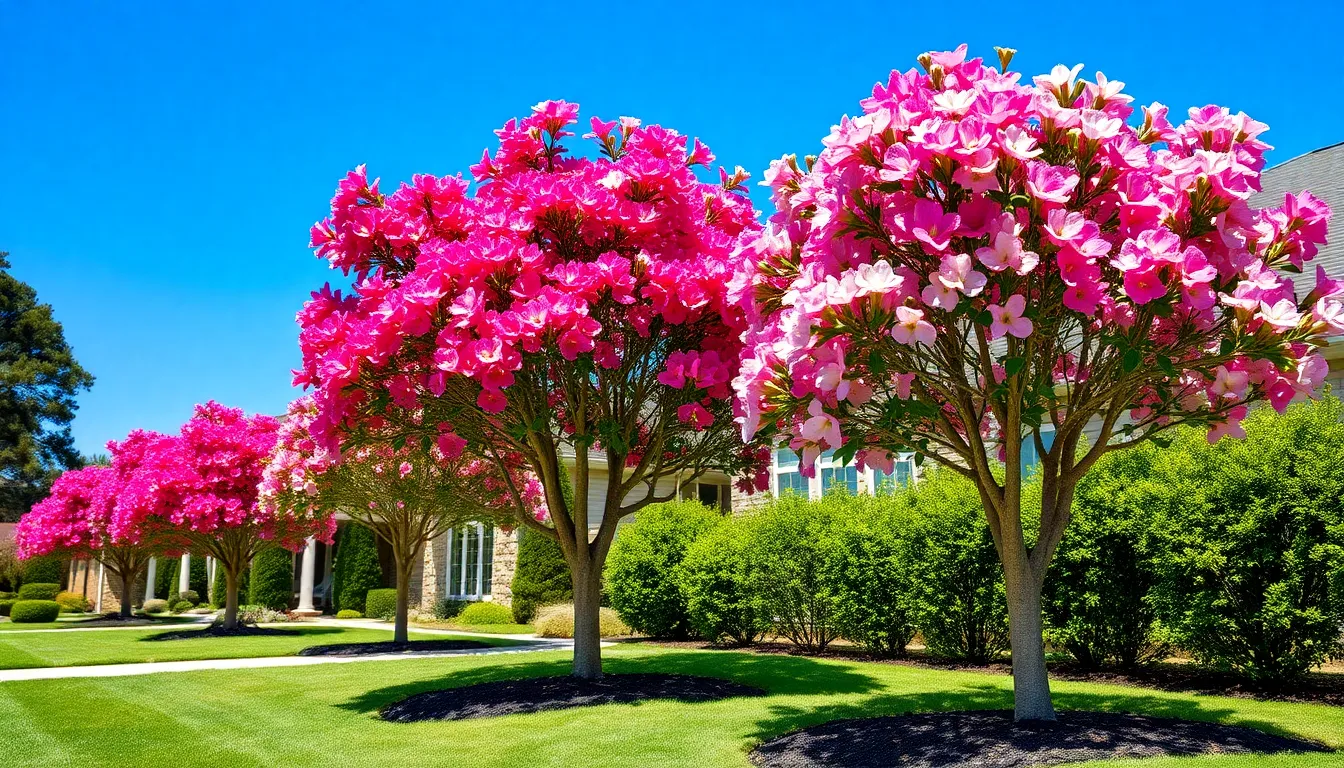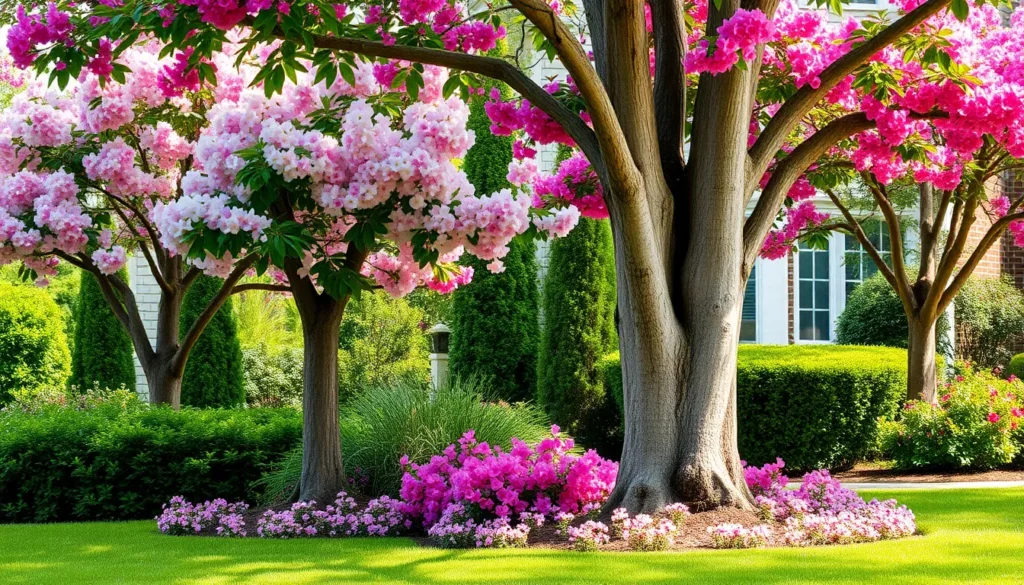Table of Contents
ToggleTransforming a front yard into a stunning oasis doesn’t have to be a Herculean task. Enter the crepe myrtle—a flowering superstar that’s ready to steal the show. With their vibrant blooms and stunning bark, these beauties not only elevate curb appeal but also make your neighbors green with envy. Who knew landscaping could be so glamorous?
Importance of Front Yard Landscaping
Curb appeal significantly impacts a property’s value and perception. Enhancing the front yard with attractive elements, such as crepe myrtle trees, draws neighbors’ admiration and sets the tone for the entire home. Landscaping plays a pivotal role in introducing a welcoming atmosphere while increasing property desirability.
A visually pleasing front yard creates a positive first impression. Crepe myrtles add not just vibrant blooms but also textured bark, contributing to a dynamic landscape. Regular maintenance ensures these plants flourish, providing year-round beauty and attracting pollinators like butterflies and bees.
Investment in front yard landscaping offers practical benefits too. Properly designed landscapes improve drainage and prevent soil erosion. Selectively placed crepe myrtles offer shade, helping lower energy costs during hot summer months. Furthermore, these trees can create natural privacy barriers, enhancing outdoor living spaces.
Neighbors and visitors often notice well-maintained front yards. A curated landscape reflects pride in ownership and invites engagement with the community. Selecting appropriate plants, such as crepe myrtles, complements existing architectural styles, ensuring a cohesive design.
Transforming the front yard into an eye-catching area encourages outdoor activities. Families can enjoy gatherings or simply relax in a more appealing environment. Moreover, beautifully landscaped spaces can inspire local gardening efforts, promoting a sense of community and shared responsibility.
Benefits of Crepe Myrtles

Crepe myrtles offer numerous advantages in front yard landscaping, enhancing beauty, functionality, and community appeal.
Aesthetic Appeal
Crepe myrtles provide vibrant blooms that attract attention. These flowering trees come in various colors, including pink, white, lavender, and red, allowing for diverse landscaping themes. Blooms last from summer to fall, ensuring prolonged visual interest throughout the seasons. Additionally, the attractive bark features a mottled appearance that enhances overall landscape character. Their natural shape offers graceful elegance, making them suitable for different styles, whether formal or casual. Blending crepe myrtles into garden beds adds depth and texture, creating a multi-dimensional landscape that captivates onlookers.
Low Maintenance Requirements
Crepe myrtles require minimal upkeep, making them a practical choice for homeowners. Once established, these trees thrive with little watering, ideally suited for regions with moderate rainfall. Regular pruning promotes healthy growth and a more aesthetically pleasing shape, but this task demands less time compared to other landscape plants. Insects and diseases tend to avoid crepe myrtles, reducing the need for pesticide treatments. Mulching around their base helps retain moisture and suppress weeds, simplifying maintenance further. These factors contribute to a stress-free gardening experience, appealing to busy individuals and families.
Choosing the Right Variety
Choosing the right variety of crepe myrtle is crucial for effective front yard landscaping. Different types offer unique attributes that cater to various aesthetics and climates.
Popular Crepe Myrtle Varieties
Several popular crepe myrtle varieties stand out for their beauty and adaptability. Lagerstroemia indica, or the common crepe myrtle, features vibrant flowers in colors like pink, white, and purple. Natchez excels with its white blooms and smooth bark, making it a favorite for classic landscapes. Muskogee boasts lavender flowers and a tall structure, perfect for providing height. Crape Myrtle Acoma offers a dwarf option, ideal for smaller spaces. Selecting from these varieties enhances design options and overall impact.
Factors to Consider
Specific factors play a significant role in selecting the ideal crepe myrtle. Growth habit influences spacing; tall varieties need more room compared to dwarf ones. Assessing hardiness zones guarantees successful growth in local climates. Flower color impacts overall aesthetics; vibrant colors can attract pollinators and add interest. Additionally, maintenance requirements often differ; some varieties may need regular pruning while others thrive with minimal care. Consider all these aspects before making a final decision for front yard landscaping.
Designing Your Landscape
Creating a visually appealing landscape with crepe myrtles involves thoughtful design choices. Effective placement enhances both aesthetic and functional qualities within the space.
Placement and Spacing
Strategic placement of crepe myrtles in a front yard maximizes their visual impact. Positioning these trees at least 6 to 10 feet apart allows room for their mature size, which can reach heights of 10 to 30 feet, depending on the variety. Planting them closer to walkways or entry points draws immediate attention. Situating crepe myrtles near seating areas can create inviting focal points, enhancing outdoor enjoyment. The right spacing between plants promotes air circulation, reducing the risk of fungal diseases.
Complementary Plants
Selecting complementary plants elevates the overall design of a front yard. Consider incorporating low-maintenance perennials like daylilies or black-eyed Susans to provide bursts of color throughout the growing season. Incorporating ornamental grasses, such as fountain grass or blue fescue, adds texture and movement. These plants thrive in similar conditions, supporting a cohesive landscape. Additionally, shrubs like boxwoods or azaleas offer a contrasting structure, framing the crepe myrtles beautifully. Combining various plant types encourages biodiversity, attracting pollinators and wildlife to the yard.
Care and Maintenance Tips
Proper care and maintenance of crepe myrtles ensures their beauty and longevity. Water trees deeply during dry spells, aiming for about 1 inch of water per week. Mulching around the base conserves moisture and suppresses weeds, promoting healthy growth.
Pruning should occur in late winter or early spring before new growth begins. Removing dead or crossing branches improves air circulation and light penetration. Fertilization with a balanced, slow-release fertilizer supports vigorous blooming, ideally applied in early spring.
Pest management requires periodic inspections. Monitor for aphids, scale, or spider mites, addressing issues through organic treatments or insecticidal soap as necessary. Disease prevention relies on ensuring proper spacing between trees, minimizing humidity that fosters fungal infections.
Regularly check soil drainage to prevent waterlogging, which can lead to root rot. Adjust the surrounding landscape if necessary to enhance drainage and promote healthy roots. Incorporating companion plants may foster a balanced ecosystem, attracting beneficial insects that help control pests.
Seasonally assessing foliage health aids in managing nutrient needs. Yellowing leaves may indicate nutrient deficiencies or overwatering. Observations should guide amendments to the care regimen to maintain the trees’ vibrant appearance.
Taking these steps helps ensure the visual appeal of front yard landscapes featuring crepe myrtles while creating an inviting atmosphere for pollinators and enhancing curb appeal. Regular attention to their needs reflects pride in ownership and fosters healthy growth, ensuring the landscape remains an attractive asset throughout the year.
Landscaping a front yard with crepe myrtles offers a blend of beauty and practicality that enhances any home. Their vibrant blooms and striking bark not only elevate curb appeal but also contribute to a welcoming atmosphere. By selecting the right variety and thoughtfully positioning these trees, homeowners can create a stunning landscape that thrives year-round.
Regular maintenance ensures that crepe myrtles remain healthy and visually appealing while attracting beneficial pollinators. With their low upkeep requirements and resilience to pests, these trees are an ideal choice for anyone looking to invest in their outdoor space. Ultimately, a front yard adorned with crepe myrtles reflects a commitment to beauty and community, inspiring others to embrace the joys of landscaping.







